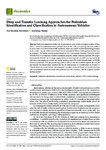Deep and Transfer Learning Approaches for Pedestrian Identification and Classification in Autonomous Vehicles
| dc.contributor.author | Mounsey, A | |
| dc.contributor.author | Khan, Asiya | |
| dc.contributor.author | Sharma, S | |
| dc.date.accessioned | 2022-02-08T12:13:21Z | |
| dc.date.available | 2022-02-08T12:13:21Z | |
| dc.date.issued | 2021-12-18 | |
| dc.identifier.issn | 1450-5843 | |
| dc.identifier.issn | 2079-9292 | |
| dc.identifier.other | ARTN 3159 | |
| dc.identifier.uri | http://hdl.handle.net/10026.1/18662 | |
| dc.description.abstract |
<jats:p>Pedestrian detection is at the core of autonomous road vehicle navigation systems as they allow a vehicle to understand where potential hazards lie in the surrounding area and enable it to act in such a way that avoids traffic-accidents, which may result in individuals being harmed. In this work, a review of the convolutional neural networks (CNN) to tackle pedestrian detection is presented. We further present models based on CNN and transfer learning. The CNN model with the VGG-16 architecture is further optimised using the transfer learning approach. This paper demonstrates that the use of image augmentation on training data can yield varying results. In addition, a pre-processing system that can be used to prepare 3D spatial data obtained via LiDAR sensors is proposed. This pre-processing system is able to identify candidate regions that can be put forward for classification, whether that be 3D classification or a combination of 2D and 3D classifications via sensor fusion. We proposed a number of models based on transfer learning and convolutional neural networks and achieved over 98% accuracy with the adaptive transfer learning model.</jats:p> | |
| dc.format.extent | 3159-3159 | |
| dc.language | en | |
| dc.language.iso | en | |
| dc.publisher | MDPI AG | |
| dc.subject | pedestrian identification | |
| dc.subject | classification | |
| dc.subject | autonomous vehicles | |
| dc.subject | CNN | |
| dc.subject | transfer learning | |
| dc.title | Deep and Transfer Learning Approaches for Pedestrian Identification and Classification in Autonomous Vehicles | |
| dc.type | journal-article | |
| dc.type | Journal Article | |
| plymouth.author-url | https://www.webofscience.com/api/gateway?GWVersion=2&SrcApp=PARTNER_APP&SrcAuth=LinksAMR&KeyUT=WOS:000737467500001&DestLinkType=FullRecord&DestApp=ALL_WOS&UsrCustomerID=11bb513d99f797142bcfeffcc58ea008 | |
| plymouth.issue | 24 | |
| plymouth.volume | 10 | |
| plymouth.publication-status | Published online | |
| plymouth.journal | Electronics | |
| dc.identifier.doi | 10.3390/electronics10243159 | |
| plymouth.organisational-group | /Plymouth | |
| plymouth.organisational-group | /Plymouth/Faculty of Science and Engineering | |
| plymouth.organisational-group | /Plymouth/Faculty of Science and Engineering/School of Engineering, Computing and Mathematics | |
| plymouth.organisational-group | /Plymouth/REF 2021 Researchers by UoA | |
| plymouth.organisational-group | /Plymouth/REF 2021 Researchers by UoA/UoA12 Engineering | |
| plymouth.organisational-group | /Plymouth/Users by role | |
| plymouth.organisational-group | /Plymouth/Users by role/Academics | |
| dcterms.dateAccepted | 2021-12-15 | |
| dc.rights.embargodate | 2022-2-10 | |
| dc.identifier.eissn | 2079-9292 | |
| dc.rights.embargoperiod | Not known | |
| rioxxterms.versionofrecord | 10.3390/electronics10243159 | |
| rioxxterms.licenseref.uri | http://www.rioxx.net/licenses/all-rights-reserved | |
| rioxxterms.licenseref.startdate | 2021-12-18 | |
| rioxxterms.type | Journal Article/Review |


